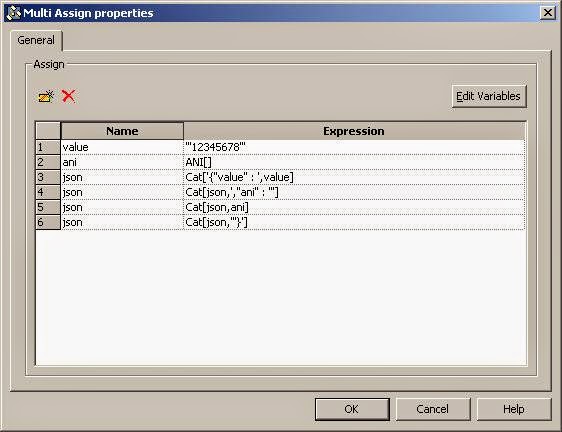This article is a continuation of my previous discussion regarding web service access from Genesys strategies. In that article, I described how to access traditional/SOAP-based web services from Genesys Interaction Routing Designer(IRD)-created routing strategies. For this article, I show how to access REST-ful web service implementations with IRD strategies.
HTTP Post Implementation
Figure 1 depicts a simplistic/non-production ready strategy that executes a HTTP POST call with a JSON parameter. The web service returns a phone number that the strategy subsequently uses as a transfer target.
 |
| Figure 1 |
In Figure 2 I'm using a Multi-assign object to build up a JSON-formatted string that will be used as an input parameter to the POST call. The resultant string looks like this:
{ "value" : '12345678', "ani" : '<the actual ANI of the inbound call to this strategy>' }
That string is assigned to a Genesys variable named 'json'.
 |
| Figure 2 |
Figure 3 shows the General Tab of the IRD web service object. Here I'm setting up a HTTP POST call to a SSL-based REST service. I explained how to configure Universal Routing Server (URS) for SSL access in this post. The input parameter of this HTTP call will be sent as an application/json content type in the request body.
 |
| Figure 3 |
The Security tab of the web service object is depicted in Figure 4. This tab sets up HTTP Basic Authentication for this POST call. In this type of authentication credentials are passed in clear text, hence, by itself, basic authentication is inherently insecure. However, combining basic auth with HTTPS does provide a fairly secure interface. The authentication credentials are encrypted in TLS.
 |
| Figure 4 |
Finally, Figure 5 shows the Result tab of this web service object. As was discussed in my previous post, Genesys URS will return the results of a web service call into an IRD List object.
 |
| Figure 5 |
In Figure 6, I pull the first item off this List object and assign it to an IRD variable called 'transferTarget'. This web service call returns a JSON object with 3 properties. The value of the first property of this JSON object is a phone number. That phone number (now in the 'transferTarget' variable) is passed to a TRoute function which initiates a transfer.
 |
| Figure 6 |
HTTP Delete Implementation
Figure 7 depicts a simple IRD strategy for illustrating a REST Delete operation. This strategy accepts a call transferred from 3rd Party IVR, CTI framework, etc. Based on ANI and DNIS, the strategy performs a fetch of the data associated with the call that was stored by the 3rd Party system. The fetch is implemented as an HTTP Delete. The Delete returns the data associated with the call and clears that data item from storage.
 |
| Figure 7 |
 |
| Figure 8 |
The IRD Web Service object is shown in Figure 9. The 'Web Service URL' parameter is set to the URL I built up in the previous step. The 'Method' is set to DELETE. Otherwise, this object is configured identically to the previous (Figure 3).
 |
| Figure 9 |
The remainder of this strategy is straight-forward. The value fetched from the REST call is attached and then the call is routed to a skill. The agent receives a screen-pop with that attached data item. Copyright ©1993-2024 Joey E Whelan, All rights reserved.